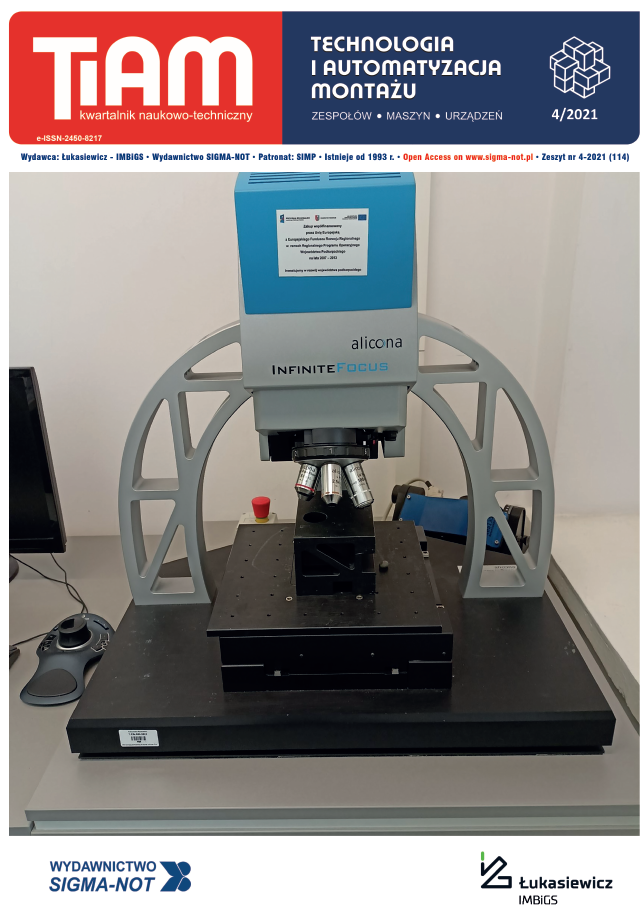Abstract
The aim of the work was to investigate the effect of thermal shocks on the load capacity of cylindrical adhesive joints. The adhesive joints are made of ENAC-AlSi7Mg0.3 aluminum alloy (sleeve) and glass-epoxy compositeEP405-GE (pivot). The elements were joined together with the Araldite 2014 adhesive composition. The thicknesses of the adhesive layer were 0.025 mm, 0.075 mm or 0.125 mm. The adhesive joints were subjected to 0, 50, 100 or 150 cycles of temperature changes. The maximum temperature was 60˚C and the minimum temperature was -20˚C. The results of the strength tests show that in the accepted range of variability of input factors, subjecting the joints to thermal shocks had a positive effect on their load capacity. The highest values of load capacity were observed for joints with 0.125 mm or 0.075 mm thick adhesive layer, which were subjected to 150 cycles of temperature changes. According to the results of the regression and correlation analysis, within the adopted range of input factors variability, the number of cycles of temperature changes has a statistically significant influence on the load capacity. It has been shown that the load capacity of adhesive joints increases with an increase in the number of cycles of temperature changes. Student's t-test shows that statistically significant differences in the load capacity of adhesive joints subjected to a different number of thermal shocks cycles occur in the case of variants: G075L0 (adhesive layer thickness 0.075 mm, number of cycles 0) and G075L150 (adhesive layer thickness 0.075 mm, number of cycles 150) and variants: G125L0 adhesive layer thickness 0.125 mm, number of cycles 0) and G125L150 (adhesive layer thickness 0.125 mm, number of cycles 150).
This is an Open Access article distributed under the terms of the Creative Commons Attribution License CC BY 4.0 (https://creativecommons.org/licenses/by/4.0/)
References
Aluminium alloy EN AC-AlSi7Mg0.3 technical data, [access September 2021], http://www.steelnumber.com/en/steel_al¬loy_composition_eu.php?name_id=1225
Araldite 2014 technical data, [access September 2021], http://www.adhesivehelp.com/productdatasheets/hunts¬man-a2014.pdf
Bielecki J., Wańkowicz J. 2014. “Nieznormalizowane wy¬magania i kryteria oceny kompozytowych wsporczych izolatorów stacyjnych do sieci 110 kV i 220 kV”. Przegląd Elektrotechniczny 10: 106–109.
Comyn J. 2018. Thermal Properties of Adhesives. In da Silva L. F. M., Öchsner A., Adams R. D. (ed.) Handbook of Adhesion Technology, 459-487. Springer International Pu¬blishing AG.
da Silva L. F. M, Adams R. D. 2007. “Joint strength predic¬tions for adhesive joints to be used over a wide temperaturę 362–379.
da Silva L. F. M., Öchsner A., Adams R. D. 2018. “Intro¬duction to Adhesive Bonding Technology”. In da Silva L. F. M., Öchsner A., Adams R. D. (ed.) Handbook of Adhesion Technology, 1-7. Springer International Publishing AG.
Hirulkar N. S., Jaiswal P. R., Reis P.N.B., Ferreira J.A.M. 2020. “Effect of hygrothermal aging and cyclic thermal shocks on the mechanical performance of single-lap adhe¬sive joints”. International Journal of Adhesion & Adhesives 99: 102584.
Kłonica M. 2015. “Impact of Thermal Fatigue on Young’s Modulus of Epoxy Adhesives”. Advances in Science and Technology Research Journal 9:103–106.
Kłonica M. 2016. “Comparative Analysis of Effect of Ther¬mal Shock on Adhesive Joint Strength”. Advances in Scien¬ce and Technology Research Journal 10 : 263–268.
Kłonica M. 2017. “Wpływ zmiennych obciążeń cieplnych na bezpieczeństwo klejonych konstrukcji lotniczych”. In Bielawski R., Grenda B. (ed.) Bezpieczeństwo lotnicze w aspekcie rozwoju technologicznego. Warszawa: Wydaw¬nictwo Akademii Sztuki Wojennej.
Kłonica M., Kuczmaszewski J. 2015. „Badania porównaw¬cze wytrzymałości na ścinanie klejowych połączeń zakład¬kowych stali 316L po „szokach termicznych””. Przetwórstwo Tworzyw 2: 125–130.
Kubit A., Bucior M., Kluz R. 2020. “Effect of temperature on the shear strength of GFRP-aluminium alloy 2024-T3 single lap joint”. Technologia i Automatyzacja Montażu 1: 30–35.
Kubit A., Trzepieciński T., Kłonica M., Hebda M., Pytel M. 2019. “The influence of temperature gradient thermal shock cycles on the interlaminar shear strength of fibre metal la¬minate composite determined by the short beam test”. Composites Part B 176 : 107217.
Kuczmaszewski J., Kłonica M., Pieśko P., Zagórski I. 2015. „Klejenie w technologii szybkiego prototypowania”. Mecha¬nik 12 : 117-120.
PN-EN ISO 10123:2019-07. Adhesives – Determination of shear strength of anaerobic adhesives using pin-and-collar specimens. Warsaw: Polish Committee for Standardization.
PN-EN ISO 4287:1999. Specifications of product geometry - Geometric structure of the surface: profile method - Terms, definitions and parameters of the geometric structure of the surface. Warsaw: Polish Committee for Standardization.
Ramalho L.D.C., Campilho R.D.S.G., Belinha J., da Silva L.F.M. 2020. “Static strength prediction of adhesive joints: A review”. International Journal of Adhesion & Adhesives 96: 102451.
Rojek M. 2011. Metodologia badań diagnostycznych war¬stwowych materiałów kompozytowych o osnowie polimero¬wej. Open Access Library.
Rudawska A., Sikora J. W., Müller M., P. Valášek. 2020. “The effect of environmental ageing at lower and sub-zero temperatures on the adhesive joint strength”. International Journal of Adhesion&Adhesives 97:102487.
Szabelski J., Domińczuk J., Kuczmaszewski J. 2019. Wpływ ciepła na właściwości połączeń klejowych. Lublin: Wydawnictwo Politechniki Lubelskiej.
Zielecki W., Guźla E., Bielenda P. 2020. “The Influence of Natural Seasoning on the Load Capacity of Cylindrical Adhesive Joints”. Technologia i Automatyzacja Montażu 3: 15-24.


